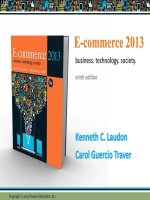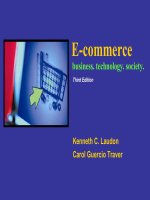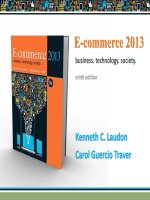Lecture E-commerce (7/e): Chapter 6 - Kenneth C. Laudon, Carol Guercio Traver
Bạn đang xem bản rút gọn của tài liệu. Xem và tải ngay bản đầy đủ của tài liệu tại đây (2.04 MB, 52 trang )
Ecommerce
business. technology. society.
seventh edition
Kenneth C.
Laudon
Carol Guercio
Traver
Copyright © 2011
Pearson Education, Inc.
Copyright © 2011 Pearson Education, Inc.
Chapter 6
E-commerce Marketing Concepts
Copyright © 2011
Pearson Education, Inc.
Copyright © 2011 Pearson Education, Inc.
Copyright © 2010 Pearson Education, Inc.
Slide 62
Netflix
Strengthens and Defends Its Brand
Class Discussion
What was Netflix’s first business model? Why
did this model not work and what new model did
it develop?
Why is Netflix attractive to customers?
How does Netflix distribute its videos?
What is Netflix’s “recommender system?”
How does Netflix use data mining?
Is video on demand a threat to Netflix?
Copyright © 2011
Pearson Education, Inc.
Slide 63
Consumers Online: The Internet
Audience and Consumer Behavior
Around
70% (82 million) U.S. households
have Internet access in 2010
Growth
rate has slowed
Intensity
and scope of use both increasing
Some
demographic groups have much
higher percentages of online usage than
others
Copyright © 2011
Gender, age, ethnicity, community type, income, education
Pearson Education, Inc.
Slide 64
The Internet Audience and Consumer
Behavior (cont’d)
Broadband
audience vs. dial-up audience
Purchasing behavior affected by
neighborhood
Lifestyle and sociological impacts
Use
of Internet by children, teens
Use of Internet as substitute for other social activities
Media
choices
Traditional
media competes with Internet for attention
Copyright © 2011
Pearson Education, Inc.
Slide 65
Consumer Behavior Models
Study
of consumer behavior
Social
science
Attempts
to explain what consumers purchase
and where, when, how much and why they
buy
Consumer
Predict
Based
behavior models
wide range of consumer decisions
on background demographic factors
and other intervening, more immediate
Copyright © 2011
variables
Pearson Education, Inc.
Slide 66
A General Model of Consumer Behavior
Copyright © 2011
Figure 6.1, Page 352
Pearson Education, Inc.
SOURCE: Adapted from Kotler and Armstrong,
2009.
Slide 67
Background Demographic Factors
Culture:
Broadest impact
Subculture
(ethnicity, age, lifestyle,
geography)
Social
Reference
groups
Direct reference groups
Indirect reference groups
Opinion leaders (viral influencers)
Lifestyle groups
Psychological
Copyright © 2011
Psychological profiles
Pearson Education, Inc.
Slide 68
The Online Purchasing Decision
Psychographic
Combines
research
demographic and psychological data
Divides
market into groups based on social class,
lifestyle, and/or personality characteristics
Five
stages in the consumer decision
process:
1.
Awareness of need
2.
Search for more information
3.
Evaluation of alternatives
4. Actual purchase decision
Copyright © 2011
Pearson Education, Inc.
5. Post-purchase contact with firm
Slide 69
The Consumer Decision Process and
Supporting Communications
Copyright © 2011
Figure 6.3, Page 356
Pearson Education, Inc.
Slide 610
A Model of Online Consumer Behavior
Decision
process similar for online and
offline behavior
General online behavior model
Consumer
skills
Product characteristics
Attitudes toward online purchasing
Perceptions about control over Web environment
Web site features
Clickstream
behavior: Transaction log for
Copyright © 2011
consumer from search engine to purchase
Pearson Education, Inc.
Slide 611
A Model of Online Consumer Behavior
Copyright © 2011
Figure 6.4, Page 357
Pearson Education, Inc.
Slide 612
A Model of Online Consumer Behavior
Clickstream
factors include:
Number of days since last visit
Speed of clickstream behavior
Number of products viewed during last visit
Number of pages viewed
Supplying personal information
Number of days since last purchase
Number of past purchases
Clickstream
marketing
Copyright © 2011
Pearson Education, Inc.
Slide 613
Shoppers: Browsers and Buyers
Shoppers: 87% of Internet users
72%
buyers
16% browsers (purchase offline)
One-third offline retail purchases influenced by
online activities
Online traffic also influenced by offline brands
and shopping
E-commerce and traditional commerce are
coupled: part of a continuum of consuming
Copyright © 2011
behavior
Pearson Education, Inc.
Slide 614
Online Shoppers and Buyers
Copyright © 2011
Figure 6.5, Page 359
Pearson Education, Inc.
SOURCE: Based on data from eMarketer, Inc.,
2010b
Slide 615
What Consumers Shop for and
Buy Online
Big ticket items ($500 plus)
Travel,
computer hardware, consumer electronics
Expanding
Consumers more confident in purchasing costlier
items
Small ticket items ($100 or less)
Apparel,
books, office supplies, software, etc.
Sold by first movers on Web
Physically small items
High margin items
Copyright © 2011
Broad selection of products available
Pearson Education, Inc.
Slide 616
What Consumers Buy Online
Copyright © 2011
Figure 6.6, Page 361
SOURCES: Based on data from eMarketer, Inc., 2010b; Internet Retailer, 2010.
Pearson Education, Inc.
Slide 617
Intentional Acts: How Shoppers Find
Vendors Online
Search
engines (59%)
Coupon
Web sites (29%)
Comparison
shopping sites (27%)
newsletters (25%)
Online
shoppers are highly intentional,
looking for specific products, companies,
services
Copyright © 2011
Pearson Education, Inc.
Slide 618
Copyright © 2011
Table 6.6, Page 362
Pearson Education, Inc.
SOURCES: Based on data from eMarketer, Inc., 2010c
Slide 619
Trust, Utility, and Opportunism in Online
Markets
Two
most important factors shaping
decision to purchase online:
Utility:
Better
prices, convenience, speed
Trust:
Asymmetry
of information can lead to opportunistic
behavior by sellers
Sellers can develop trust by building strong
reputations for honesty, fairness, delivery
Copyright © 2011
Pearson Education, Inc.
Slide 620
Basic Marketing Concepts
Marketing
Strategies
and actions to establish
relationship with consumer and encourage
purchases of products and services
Addresses competitive situation of industries
and firms
Seeks to create unique, highly differentiated
products or services that are produced or
supplied by one trusted firm
Unmatchable
feature set
Avoidance of becoming commodity
Copyright © 2011
Pearson Education, Inc.
Slide 621
Feature Sets
Three
1.
Core product
1.
levels of product or service
e.g. cell phone
Actual product
Characteristics that deliver core benefits
e.g. wide screen that connects to Internet
1.
Augmented product
Additional benefits
Basis for building the product’s brand
e.g. product warranty
Copyright © 2011
Pearson Education, Inc.
Slide 622
Feature Set
Copyright © 2011
Figure 6.7, Page 364
Pearson Education, Inc.
Slide 623
Products, Brands and
the Branding Process
Brand:
Expectations
consumers have when consuming, or
thinking about consuming, a specific product
Most important expectations: Quality, reliability,
consistency, trust, affection, loyalty, reputation
Branding:
Process of brand creation
Closed loop marketing
Brand strategy
Brand equity
Copyright © 2011
Pearson Education, Inc.
Slide 624
Marketing Activities:
From Products to Brands
Copyright © 2011
Figure 6.8, Page 366
Pearson Education, Inc.
Slide 625









